Video Game Review: Too Human
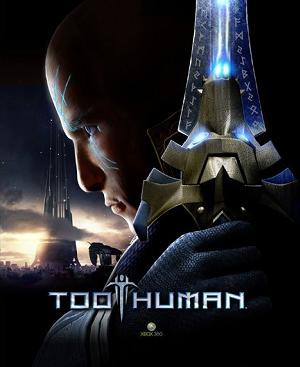 | | Too Human |
Normally, high profile video games aren’t reviewed on this site, but widely varying reviews across the Internet and other media—not to mention the ongoing flames of message board naysayers who are far too eager to hate it—make Too Human an exception. Additionally, the game made my list of Top 10 Most Anticipated Video Games a couple of months ago, at the number one spot no less, so my two cents are called for.
Too Human may not be a flawless game, but makes up for it with a great deal of originality and style. As a hybrid action/RPG with elements of God of War and Diablo, it’s unlike anything you’ve ever played, and whenever you chart a new path, you’re likely to come across a few unexpected pitfalls and obstacles. This is why it is easy to come across such a wide range of opinions about the game—some see it as a broken mess of glitches, while others see it as the dawning of a whole new genre in modern gaming. In truth, it is neither, but the most important thing missing from the argument is that, despite everything, the game is undeniably fun.
STORY
The story of Too Human takes place in a bizarre universe of the past in which the gods of Norse mythology (called the Aesir) are actually cybernetically enhanced superhumans fighting a bloody unending war against ancient machines. The idea is interesting and original, but does strike an odd balance from time to time. The writers clearly did their homework and spent an enormous amount of time considering how to incorporate the ideas of Norse mythology with the fantasy/sci-fi setting, and the end result, while it might feel a little messy, is impressive.
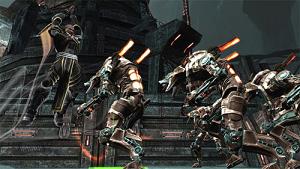 | | Baldur is quite gifted at slicing through massive groups of cybernetic goblins |
You play as Baldur, the most human of the Aesir (thus the title of the game), as he tracks down information about a startling new twist in robot behavior, tries to unlock secrets of a recent trauma he cannot remember, and goes to Hell itself (called Helheim) in search of the rogue god who appears to be at the center of the coming Ragnarok. Finding its cues in real mythology, the story takes a few entertaining liberties to meld the fantasy elements with the cyberpunk-infused setting. Yggdrasil, the world tree, for instance, is a hub of cyberspace, made up in the real world of huge wires twisted in the shape of a tree.
The whole of the story takes place near the end of Norse mythology, which is based in a dramatic climate change that ultimately wiped out the Vikings. In this version of the myth, Loki, a mischeivious god, decides that the Aesir themselves are to blame for the climate and plans to rid the world of them so that the world may prosper once again. How involved Loki and his daughter, Hel, are in everything that happens is one of the underlying mysteries of the game, one that is never fully resolved (Too Human is the first game in a planned trilogy, so these underlying mysteries are likely to be addressed in the future installments).
 | | Loki appears to be the primary antagonist, but one can't be truly sure of anything in this story |
The story—which never resorts to handholding—is multicentric and complex, so much so that you might not understand it until the second playthrough, especially if you don’t know anything about Norse mythology. The characters are memorable and idiosyncratic, and they clearly drive the plot forward.
Unfortunately, the plot doesn’t flow quite right for a video game. It’s epic, to be sure, but is so cryptic that it doesn’t motivate the character to take part in the quests, most notably in the middle two sections of the game. While Baldur’s motivations are clear enough for some missions, others seem like random excuses to go dungeon crawling and are only secondary to the story. This is apparent early in the game, when you are thrust into a dungeon before you even know why you are there.
Still, this is a minor nitpick. It should be stressed that the complex and unique story is still interwoven with grace and narrative structure, and the few twists and turns—while not unpredictable—are incredibly cool and satisfying.
GAMEPLAY
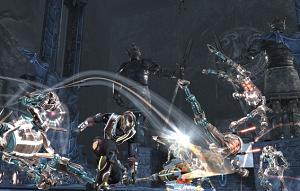 | | The action is fast, consistent, and oh so satisfying |
The gameplay, more than anything else, is what separates Too Human from other games. Fighting is accomplished using both analog sticks, along with the left and right trigger buttons. If you want to swing your sword at a nearby enemy, you simply point the right stick at your target and Baldur does all the work. You can also fire pistols and rifles at your opponent by doing the same thing while holding down the trigger, and switching between your melee weapon and your gun is seamless. There are a few special attacks that are easily triggered with a button press or by mashing both sticks in the same direction. It’s hard to describe why this control scheme feels so natural and exhilarating, but once you start playing and get used to it, you’ll understand pretty quickly.
It looses some luster, though, when you are trying to shoot. The controls are built for quick melee combat—and succeed with flying colors—but they are not the best controls for shooting mechanics. Aiming at a distance is frustratingly difficult, as is trying to hold your aim on a big baddie’s arm while jumping or dodging. Again, this is a minor complaint, and the only way to truly fix it would be to break the unique control scheme that makes the game different. With literally thousands of shooters on the market, people have gotten used to evolved shooter controls, and any change is immediately critiqued for its inefficiency.
Also, the two-stick method leaves no real way to control the camera. Before I played the game, this was my biggest concern, but in truth, the game designers did an admirable job making the cinematic camera work well. Still, no matter how perfect the computer-controlled camera is, every once in a while, the camera will be pointing in the wrong direction. For example, when you are low on health and want to flee a battle to get to that nearby container with more health in it, the camera will point behind you, at the horde of enemies at your heels. This means you can’t see where you’re running, and you’re probably going to miss the container altogether, get stuck in a corner, and then get slaughtered. But these frustrating intrusions of bad camerawork only occur about once every two or three hours, which is extremely rare for a game that only clocks in at about twelve hours.
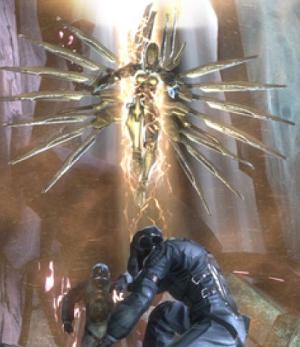 | | Valkyries make regular appearances to take the dead to Valhalla (or in your case, just to the front of the room) |
All in all, and despite the nitpicks, the ballsy control scheme is a success. It is extremely fun to rock the right stick back and forth and watch as Baldur races from enemy to enemy, clobbering the cybernetic snot out of hundreds of goblins at a time.
The dungeons are pretty linear, though, with only a few hidden areas and secret offshoots (much like the critically-acclaimed God of War). Finding them all is made extra difficult due to an inability to backtrack, but once you finish the game, you can freely explore any of the game’s four levels at your whim.
The other major component of the gameplay is the incredibly deep loot system. Killing enemies, breaking containers, and opening obelisks will reward you with various armor, weapons, runes, blueprints, charms, and the usual health and money. You can spend several hours customizing your character, even going so far as buying runes that will change the color of your equipment. Then, after playing for another half of an hour or so, you can repeat the process with all your new loot (or you can choose to only customize every once in awhile, and do so quickly, if micromanagement isn’t your thing).
This can be fun, but due to the overly efficient balancing of enemies to your skill level, you can never weild that one weapon that makes you feel godlike or put on that one piece of armor that makes you invincible. This is a trait found in many modern RPGs, including the excellent Mass Effect and The Elder Scrolls IV: Oblivion, and has never really worked for me. In Too Human, the enemies stay relatively the same throughout the game, even if the configuration from room to room is varied, and no matter how powerful you are, there will always be tough enemies to take down. Eventually, this can get boring, and the motivation for getting stronger weapons and armor depletes fairly rapidly once you realize it doesn’t ultimately matter. I want to stress that this is not a unique problem for Too Human; some reviewers argue that it makes the game deserving of a low score, despite the fact that these same reviewers gave their highest scores to games like Mass Effect and Oblivion, which clearly suffer from the exact same design choice.
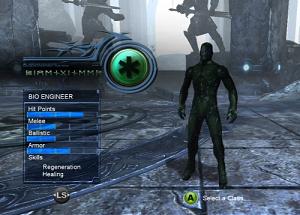 | | Different classes open up an immense amount of variety |
Dying is interesting, too. The penalties for getting killed are pretty meager: your equipment takes minor damage and your combo meter (which dictates your usage of special attacks and battle cries) resets to zero. The enemies you were fighting stay exactly the same—even if you’re fighting a boss—and you are simply replaced at the front of the room. You can die frequently and it won’t be a problem. This isn’t a game-breaker, but I feel like the game could have some greater penalties (halving your money or doing more serious damage to your equipment come to mind) to add weight to the gameplay. Then again, not having any serious penalties for dying keeps the game from being so stressful it stops being fun.
What does matter, though, is your choice of class. There are five options: the well-rounded Champion, the melee-centered Berzerker, the shooter Commando, the healing Bioengineer, and the nearly indestructible Defender. The gameplay feels significantly different from class to class, and the balancing is decent. If you don’t like dying, the Bio-Engineer will keep you alive; if you like being in the thick of the fight at all times, the Berzerker is your man. If you get hooked on the game, you will eagerly play again and again to try them all out, and you will not be disappointed.
The multiplayer consists of two-player online co-op, which is fun but limited. I can see how four-player co-op might get a little too insane, but it’s also apparent that a group of two is hardly a group at all. With the possible combinations of available classes and the bonuses of group skills and battle cries, it seems odd that the game designers couldn’t try for at least three players at a time.
[Gameplay: 40/50]
[Controls/Game Design: 16/20]
[Fun: 10/10]
[Replay: 9/10]
[Multiplayer: 5/10]
|
|
PRESENTATION
The graphics in Too Human are intense. Dungeons are made up of spacious expanses and beautiful panoramas, and the art direction is pitch-perfect. Hidden load times have the game flowing without stop, and character designs—which are rendered the same way regardless of whether they’re in the thick of battle or the highlight of a cutscene—are awesome in their detail. Granted, cutscenes rendered with the game engine aren’t the most beautiful cutscenes to be found, but if a separate engine were used to render more detail, the game would be hampered by load times. The framerate rarely ever drops, even when there are a hundred enemies on the screen at once in a chamber the size of a small city, and I never once noticed a texture pop-in.
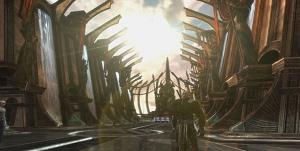 | | The graphics and settings are bold, expansive, and beautiful, even when they're being overrun by hordes of the undead |
The sound is equally impressive. Voice acting is top-notch—which is amazing considering the inevitable cheese of Norse-inspired dialogue mixed with heavy cyberpunk—battle noises are thrilling, and the music is sweeping and emotional. However, it would be nice if there were an option to adjust the balance between voice, sound, and music, especially considering the fact that there are times where it feels grossly out of balance. During battle, the music and effects are intensely loud, but then, during a cutscene, the voices are quiet, with little or no music. This can lead to blown-out speakers or a constant need to adjust the volume, which is frustrating. At least the option for subtitles is there, since you will likely be hearing impaired after playing this game.
Other elements of the presentation are well-done, especially the main menu, the in-game cutscenes (during which you can often manipulate Baldur), and the abundance of content. The game is way too short, but the promise of sequels is welcome.
There are many minor flaws in Too Human, but they in no way break or ruin the game. It is incredibly fun, admirably crafted, and extremely deep. The nitpicks are easy to make, but one must remember that they come from the fact that this game is doing things that no game has ever done before. It may not be the game I’ve been waiting nearly a decade for, but it’s still a great game and well worth your money. Hopefully, it won’t take Silicon Knights another ten years to finish the next installment, which is certain to iron out some of the wrinkles.
[Presentation: 27/30]
[Graphics: 10/10]
[Music & Sound: 10/10]
[Extras & Miscellany: 7/10]
|
|
FINAL TALLY
STORY: 18/20
GAMEPLAY: 40/50
PRESENTATION: 27/30
BONUS POINTS: 1
(for originality)
TOTAL SCORE: 86/100 |
|
-e. magill, 08/25/2008
|
|